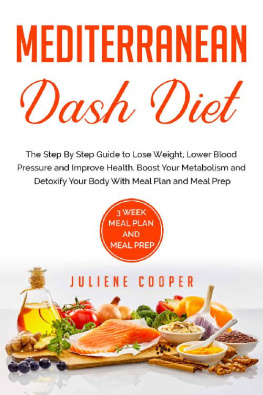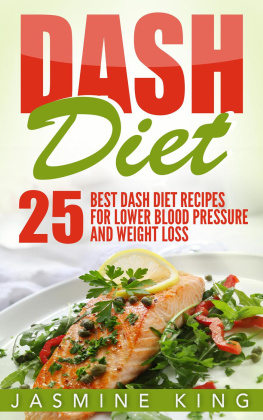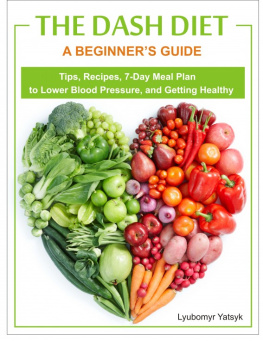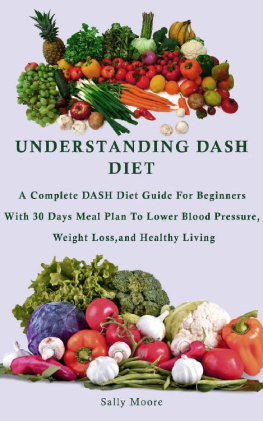Mediterranean
dash diet
The Step by Step Guide to Lose Weight, Lower Blood Pressure and Improve Health.
Boost Your Metabolism and Detoxify Your Body With Meal Plan and Meal Prep.
Juliene Cooper
Copyright 2020 - All rights reserved.
The content contained within this book may not be reproduced, duplicated or transmitted without direct written permission from the author or the publisher.
Under no circumstances will any blame or legal responsibility be held against the publisher, or author, for any damages, reparation, or monetary loss due to the information contained within this book. Either directly or indirectly.
Legal Notice:
This book is copyright protected. This book is only for personal use. You cannot amend, distribute, sell, use, quote or paraphrase any part, or the content within this book, without the consent of the author or publisher.
Disclaimer Notice:
Please note the information contained within this document is for educational and entertainment purposes only. All effort has been executed to present accurate, up to date, and reliable, complete information. No warranties of any kind are declared or implied. Readers acknowledge that the author is not engaging in the rendering of legal, financial, medical or professional advice. The content within this book has been derived from various sources. Please consult a licensed professional before attempting any techniques outlined in this book.
By reading this document, the reader agrees that under no circumstances is the author responsible for any losses, direct or indirect, which are incurred as a result of the use of information contained within this document, including, but not limited to, errors, omissions, or inaccuracies.
Introduction
The Mediterranean DASH diet is designed to help you lower your blood pressure, improve cardiac health, reduce the risk of cancer and type 2 diabetes, and, in some cases, lose weight. The Mediterranean diet is based on a pattern of eating, cooking, and other lifestyle factors that focuses on an abundance of whole foods. These two diets overlap in many areas, but merging them fully creates a powerful duo that is sustainableand deliciousfor the long term. Its no wonder theyve been the top two diets, as ranked by U.S. News & World Report, for many years running.
Combining the two diets creates a unique approach to the DASH diet that is incredibly flexible, full of vegetarian and pescatarian options, and makes cooking at home or eating out easy and achievable. Once you get the hang of the basics and begin to build up your recipe arsenal, tweaking your favorite dishes will become second nature. You will never have to fear running out of recipe ideas again!
As someone who has a deep love for both food and health, Ive filled this book with satisfying dishes rooted in the flavorful culinary traditions of Greece, Italy, and Spain, among others, and included tips to make committing to this nutritionally balanced way of eating as easy as possible. I hope youll find the information in this book and the recipes as useful and tasty as I do.
Enough of the pep talk. Its time to get started. Lets find out what the Mediterranean DASH diet is all about, how and why it was developed, and how you can use it to improve your health!
Chapter 1: The importance of a healthy diet
Over the past 50 years, people in the western world, especially in the United States have been gaining weight. The obesity epidemic is quickly becoming a public health crisis. Obesity is linked causally to multiple diseases and the more people that become obese the more people who will be sick in the coming decades. That means higher health costs for society and declining quality of life with shortened lifespans for those who are obese.
The importance of a Healthy Weight
Doctors have always realized that being overweight was bad for you. This comes about from simple observation. People who are overweight run into a multitude of health problems, from simple joint problems to heart disease and cancer. In recent decades the obesity rate has been exploding. By the year 2000, researchers in the United States were already concerned with increasing obesity rates. By that time, 30% of adults and 14% of children under the age of 18 were considered obese. By 2015, 40% of adults and nearly 19% of children were suffering from obesity. Whats going on?
Many factors have impacted the rise of obesity. We can start with the obvious after 1950 Americans (and gradually other westerners) had increasing access to fast food, processed food, and junk food. While people either had to eat at home on a budget or at a sit-down restaurant prior to the second world war, by the end of the 1950s the country was full of fast in-an-out hamburger joints that let people get instant access to a meal. And the contents of the food werent the best in addition to a saturated fat-laden burger on a white bread bun, most would top it off with a side of deep-fried French fries loaded with salt. To wash it down, patrons would drink sugar-laden soda pop.
The grocery store evolved too, as food companies discovered ways to package carb-laden snacks that were high in salt for people to take home and eat while they sat in front of a television. They also began using artificially produced trans-fats in the snacks, since trans-fats were shelf stable and cheap. What food companies didnt know at the time was trans-fats were a major danger to heart health, as well see later.
Soda and other sugary products also filled the grocery shelves. The impact on obesity was gradual, as people were still relatively more physically active at the time. However, on average physical activity declined despite various health crazes that filled the passing decades. More and more people found themselves following a sedentary lifestyle, watching television and then playing video games.
Doctors then got led astray by early research into nutrition. A researcher named Ancel Keyes discovered that there was a correlation between high cholesterol and heart disease. The medical community jumped on this news, and since saturated fat consumption increases your cholesterol, they began promoting low-fat high-carb diets. By the 1980s it was received wisdom that a low-fat diet was the key to health. Even though half of the heart attacks occur in people with total cholesterol numbers below 200, doctors latched onto the idea that keeping your cholesterol below 200 was some kind of magic bullet that would prevent heart disease.
People actually listened to this advice, and as the decades wore on more carbs and less fat was consumed. Eggs were demonized on a Time magazine cover, and people reached for their super low-fat special K cereal which they ate with skim milk before heading off to aerobics. At the time, it was believed that foods that were high in cholesterol like egg yolks caused heart disease. Later it was found that in fact, dietary cholesterol has very little impact on your blood levels of cholesterol. Basically, your body makes cholesterol. When you eat it, your body makes less cholesterol. So eating an egg yolk has little impact.
Despite all of this, the health outcomes were not better. Diabetes rates have been increasing despite all the low-fat advice. Heart disease remains the number one killer, and any improvements through the years have been through new drugs (statins) and improved medical treatment, not via better nutrition. As we entered the 21 st century, Americans kept getting fatter.
Over the past decade, people have been sounding alarm bells. Gary Taubes, who is actually an engineer turned nutrition expert, wrote a classic book called Why we get fat . This book laid out the process of digestion of sugar for the general public and explained why fat wasnt really the problem. As well discuss later, a blood fat called triglycerides is a major problem with heart disease, and it turns out that triglycerides although they are fat actually come from sugar. Taubes and others revealed that cutting out fat from our diets has been the root of many of the health problems were now seeing.












